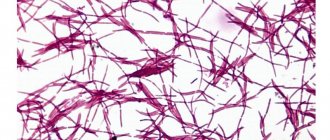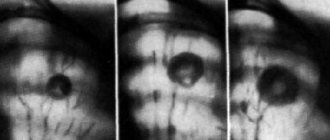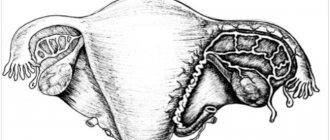According to the World Health Organization, giardiasis (giardiasis) is a parasitic disease caused by the protozoan Giardia (Lamblia intestinalis), which is common in all parts of the world. Every year, about 200 thousand people in the world become infected with giardiasis, and in developed countries from 0.5-5% of cases, in developing countries - in 18%, the incidence is high among children, pets and owners of dogs and cats.
Giardia was discovered in the 19th century by D.F. Lambl. Among parasitic diseases, giardiasis ranks second after.
Giardia exists in two forms:
- in vegetative (vegetative forms die in the external environment within 2 hours),
- in the form of cysts (giardia cysts are resistant to ultraviolet rays, chlorine, and remain viable in tap water for up to 3 months).
Vegetative forms are mobile protozoa measuring 9-20 mm in length and 5-15 mm in width; in the front part of their body there is a suction disk, which allows Giardia to adhere to the duodenal mucosa and the upper parts of the small intestine. When vegetative forms enter the large intestine, they turn into cysts, which are excreted with feces into the external environment. Moreover, if up to 100 cysts are considered sufficient to infect a person or animal, then up to 900 million Giardia cysts are released from a sick person.
Sources and mechanism of infection by Giardia cysts
Sources of Giardia infection are:
- drinking water,
- open bodies of water contaminated with untreated sewage,
- unwashed fruits, vegetables,
- dirty hands.
The entry point for parasitic infection is the gastrointestinal tract. The infectious dose is from 100 cysts. The incubation period for the development of infection is up to 25 days.
How does Giardia infection occur?
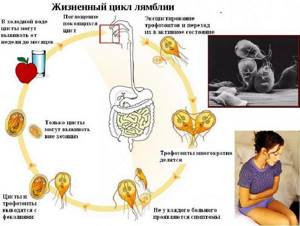
Giardia cysts from the environment enter the gastrointestinal tract of a person or animal, and they are not affected by the acid of gastric juice, the shell of the cysts dissolves only under the influence of intestinal juice and they pass into vegetative forms that live in the duodenum and jejunum, multiply quickly and damage the mucous membrane of the small intestine. Vegetative forms of Giardia are sucked onto the microvilli of the small intestine, where digestion and absorption of nutrients occurs and thus parasitize, using the nutrients of a sick person. Up to 1 million Giardia can parasitize per 1 cm2.
Production time
Analysis in the laboratory is usually done within 24 hours.
An employee conducts microscopy of the provided material, which is prepared using various reagents. The sample is applied to a glass slide and placed under a microscope.

The sample is applied to a glass slide and placed under a microscope.
The initial smear intended for study is enriched and pre-stained with 1% Lugol's solution, since the cysts themselves are transparent.
If Giardia cysts or adult organisms are found, giardiasis is diagnosed.
“Trouble-sadness-chagrin”, or the dangers of Giardia infection
Giardia waste products contribute to the development of chronic diseases of the gastrointestinal tract, disruption of some components of the immune system, which leads to frequent relapses of skin diseases and allergization of the patient's body. In the gallbladder, where bile is concentrated, Giardia does not live, but has an irritating effect on the biliary tract, causing dyskinesia - impaired motility of the gallbladder and biliary tract. Recently, the influence of Giardia on the pancreas has been shown - Giardia, having a toxic effect, disrupts its exocrine function - the formation of enzymes. If Giardia remains in the body for a long time, then waste products accumulate and chronic intoxication of the body occurs, which can affect any of its organs and systems.
The acute form of the disease is more common in children and lasts 5-7 days, similar to acute gastroenteritis.
The chronic form of infection is observed in adults and school-age children, lasts up to several months and has clinical manifestations.
In 28% of cases of giardiasis in adults, it is asymptomatic, without pronounced clinical manifestations from the gastrointestinal tract. It can occur latently, manifested by a deterioration in the quality of life, a violation of the autonomic nervous system (giardia is called the “parasite of melancholy and sadness”), and the development of allergic and dermatological diseases.
Result
If the result is positive, the report will indicate the presence of Lamblia intestinalis cysts. Also, in the presence of infection, the sample will contain mucus, starch, and leukocytes in the amount of 0-1 in the field of view.
If the option is negative, it will be indicated that no protozoa were detected. If Giardia is detected, then such a conclusion cannot be false.
Sometimes there are cases when decoding gives a false negative result, because traces of Giardia may not be present in a single stool sample. Such a result can also be obtained if the rules for taking a sample are not followed or if the preparation for the study is poor.
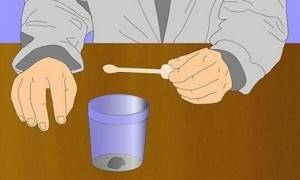
Sometimes the test gives a false negative result because traces of Giardia may not be present in a single stool sample.
If, despite a negative result, you still have all the relevant symptoms, it is recommended that you take the test again after a few days. Experts believe that an accurate diagnosis of giardiasis is normally established after a three-time confirmed result.
How does giardiasis manifest?
Allergic manifestations
There may be an acute allergic reaction or giardiasis may manifest itself as a chronic disease (atopic dermatitis, bronchial asthma). With giardiasis, the course of allergic manifestations is more severe, they have a more widespread nature of skin lesions and are characterized by a continuous recurrent course. A special feature is the lack of a positive response to traditional treatment of atopic dermatitis.
Dermatological manifestations
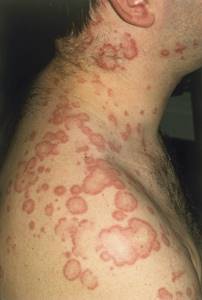
Dermatological manifestations of giardiasis have a peculiar character:
- morbilliform rash in young children occurs rarely, because children are vaccinated against measles, but sometimes rashes appear, but there are no clinical manifestations of measles;
- urticaria, accompanied by severe itching; the use of antihistamines and sorbents gives a short-term effect; urticaria can take a recurrent course, which is especially severe in adults, causing Quincke's edema and eye damage (blepharitis). The quality of life is impaired, urticaria can occur without connection with dietary errors or taking medications;
- rough “goosey” skin, often on the outer surface of the shoulders, sometimes covered with scaly plaques (follicular keratosis), which does not bother the patient, does not cause itching and does not interfere with the quality of life;
- dry skin, flaky heels (xerosis), especially in the winter season, isolated damage to the palms and soles may be observed, with the skin peeling off the tips of the fingers and they resemble “senile fingers”, but the peeling does not reach the palms; the use of emulsions, lotions, creams softens such skin, but then peeling may reappear;
- dry mucous membranes of the lips (cheilitis), which may be associated with a secondary infection.
Autonomic disorders
Human autonomic disorders with giardiasis can be as follows:
- increased nervous excitability
- tearfulness,
- headache,
- dizziness,
- restless sleep,
- weakness,
- heartbeat.
At the same time, traditional treatment of all neurotic conditions is ineffective; it is necessary to examine both the child and the adult for giardiasis.
Gastrointestinal disorders

With giardiasis there is no specific clinical picture; there are various symptoms from the gastrointestinal tract:
- pain in the abdomen, often in the peri-umbilical region, of a paroxysmal nature,
- pain in the right hypochondrium, often not associated with the intake and nature of food, which makes diagnosis difficult,
- dyspeptic complaints: nausea, bitterness in the mouth, bloating associated with intolerance to dairy products, unstable stool.
In the chronic course of giardiasis, clinical symptoms may not be clearly expressed and qualify as chronic gastroduodenitis, chronic enteritis, biliary dyskinesia.
Which doctor treats giardiasis in adults. Diagnosis of the disease
Often, with a chronic form of giardiasis, patients visit a doctor, primarily an allergist or dermatologist.
Indications for diagnostics to exclude giardiasis are:
- diarrhea,
- chronic diseases of the gastrointestinal tract,
- dermatitis,
- hives,
- autonomic disorders,
- dyspeptic complaints (nausea, feeling of fullness in the epigastric region, loss of appetite, body weight),
- intestinal discomfort (bloating, rumbling).

Without laboratory diagnostics, it is impossible to say that a person has giardiasis, but it is possible to suspect this infection and be sure to conduct special studies:
- clinical blood test, which is characterized by constant but moderate eosinophilia! (increased blood eosinophils),
- A non-invasive diagnostic method is stool microscopy, always three times with an interval of 7-8 days. It is believed that the release of Giardia cysts occurs after 8-14 days and this interval must be used to detect Giardia in the feces and conduct an enzyme-linked immunosorbent assay for the presence of Giardia antigen in the feces.

Attention! It should be borne in mind that vegetative forms of Giardia are found in warm duodenal contents or liquid feces; this form is most often diagnosed in infectious diseases hospitals.
In the chronic course of giardiasis, detection of cysts will help make a diagnosis, which is the basis for anti-giardiasis therapy.
A study of evening stool cannot be ruled out; this test is highly informative. The diagnostic value of such a test is high, because with its help it is possible to examine children and adults for giardiasis with the phenomenon of cystic discharge (Kornienko E. A. 2009). The use of choleretic drugs increases the likelihood of detecting Giardia.
Within 70 days after the start of therapy, stool is specifically examined for Giardia every 8-14 days. According to E. A. Kornienko, the most informative diagnostic method is stool examination (coproscopy), which gives an answer in 96% of cases. Also applicable
- immunoenzyme and immunochromatographic test systems that detect specific antibodies in the blood, determination of total immunoglobulins (IgG, A, M) and specific immunoglobulins of class M in blood serum and antibodies in feces. The sensitivity of these tests is 70% and specificity is 92%.
- endoscopic research methods - gastroduodenoscopy, which reveals hyperplasia of lymphoid tissue (bulges) on the surface of the duodenal bulb and lymphangiectasia at the level of the Vater papilla.
Stool antigen or PCR
Testing stool for Giardia antigen is a more reliable research method that eliminates the role of the human factor in diagnosis and is the best in terms of reliability.
The study allows us to identify not the parasites themselves and their cysts, but antibodies produced by the immune system as a response to the presence of pathogens in the body (monoclonal antibodies to the GSA-65 antigen). During the analysis, fragments, eggs and cysts of Giardia can be detected. The peculiarity of the method is that it allows you to detect Giardia even in those periods when cysts and traces of eggs are not visible in fecal matter.
Analysis of the quantity and composition of immunoenzyme proteins makes it possible to diagnose not only the fact of the disease itself, but also its stage.
It is possible to resort to research using PCR (polymerase chain reaction), detecting individual genes in Giardia DNA, but even in megacities this is a rare and expensive procedure.
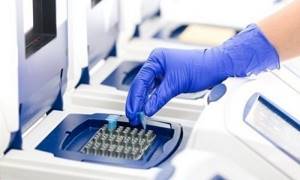
In the laboratory, the division and self-reproduction of protozoan DNA is stimulated under the influence of reagents and temperature.
In the laboratory, the division and self-reproduction of protozoan DNA is stimulated under the influence of reagents and temperature. Thanks to this, it is possible to achieve high accuracy (up to 98%).
Treatment of giardiasis
The ultimate goal of treatment is to eliminate Giardia from the intestines. The treatment uses various components of nutritional and drug treatment, which are aimed at various parts of the parasitic effect on the human body and contribute to its recovery.
Diet therapy
The dietary regimen is followed throughout the treatment. Nutrition is aimed at creating conditions that worsen the reproduction of Giardia, and the introduction of products that are food sorbents. Restriction of carbohydrates is required, especially sugar, cookies, white bread, pasta.
Introducing increased amounts of protein :
- dairy products,
- fish,
- bird,
- meat
and dietary fiber :
- porridge,
- wheat bran or grain bread,
- dried fruits,
- baked apples, pears, berries (lingonberries, cranberries),
vegetable oil.
An increased water regime (up to 1-1.5 liters per day). Fasting during giardiasis is contraindicated.
Drug therapy
Choleretic agents:
- Allohol 2 tablets 3 times after meals for 20 days,
- Hofitol 1 dr. 3 times 20 days 20 minutes before meals,
- Hepatofalk 1 caps. 2 times 20 minutes before meals for 20 days,
- Cholenzym 1 dr. 3 times after meals, etc.
Drugs that reduce body intoxication and enhance the detoxification function of the liver:
- Heptral 400 mg intravenously in 200 ml of saline solution No. 10 once a day in the morning or
- Gepatosan 1 capsule 2 times a day before meals for 10 days.
Choleretic drugs are prescribed to reduce intoxication of the body. They normalize bile secretion and intestinal function and have a detrimental effect on Giardia and many protozoa.
It is effective to cleanse the biliary system of the body before using antiparasitic drugs : 1 tablespoon of sorbitol is diluted in 300 ml of boiled water and drunk within 2 hours in the morning on an empty stomach in sips. Then, during the day, a fasting diet is followed: boiled rice, baked fruits (apples and pears) and vegetables (any), high-liquid regime up to 1.5-2 liters. Duration 1 day.
Enterosorbents
More often prescribed to those patients who have allergic manifestations. The drug that has proven itself to be the best is Smecta (Smectin), 1 packet at night. Smecta has an effect on the cells of the small intestine where Giardia lives. It is possible to take Allochol simultaneously, 2 tablets 3 times a day.
Enzyme preparations
Wobenzym has proven itself well , especially during the period of taking antiparasitic drugs. Take 2-3 tablets 3 times a day for 14 days. 40 minutes before meals.
Antihistamines
They are used for antiparasitic treatment or for manifestations of allergic diseases, for example. Suprastin 1 tablet. since morning.
Antiparasitics
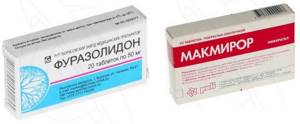
You can choose a one-day or multi-day course of treatment, but the latter gives a better effect and fewer adverse reactions. There are quite a lot of drugs and they are used more often than others: Metronidazole, Furazolidone, Nifuratel, Albendazole, Ornidazole, Tiberal, Tinidazole, Vermox, Decaris.
The choice of drug remains with the doctor.
In recent years, there has been a revision of priorities in the use of antiparasitic drugs, based on the observed possible recurrences of the disease after treatment and side effects of the drugs. In both pediatric and adult practice, the most preferred drug is currently Nifuratel , whose trade name is Macmiror .
If a parasitic infection is detected, it is necessary to consult an infectious disease specialist or gastroenterologist, carry out treatment and be sure to monitor it; if cysts are detected in other family members, the whole family should be treated.
